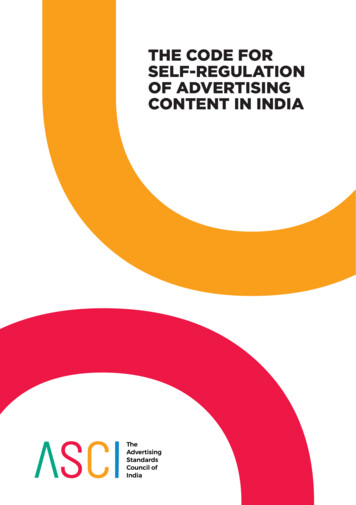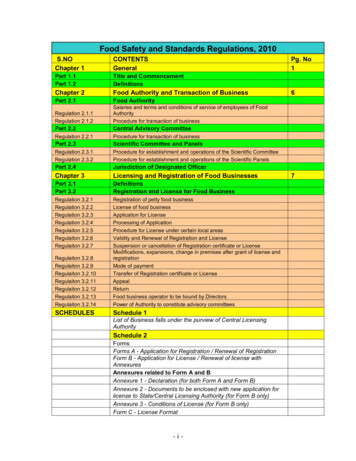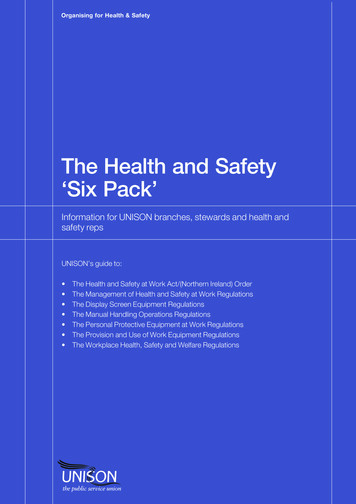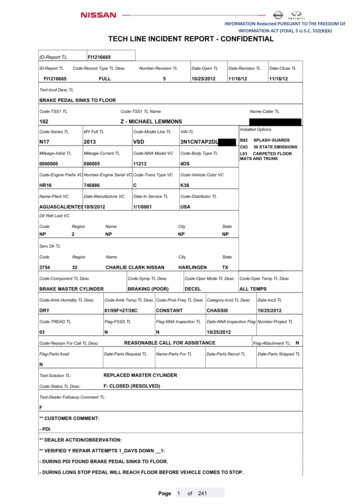
Transcription
THE CODE FORSELF-REGULATIONOF ADVERTISINGCONTENT IN INDIA
INDEXIntroduction01The Code for Self-Regulation in Advertising02 Chapter I - Truthful & Honest Representation07 Chapter II - Non-offensive to Public10 Chapter III - Against Harmful Products and Situations11 Chapter IV - Fair in Competition13Guidelines for Specific Category Ads Advertisements Depicting Automotive Vehicles15 Qualification of Brand Extension Product or Service16 Advertising of Foods & Beverages (F&B)18 Advertising of Educational Institutions and Programs20 Disclaimers made in supporting, limiting or explainingclaims made in Advertisements22 Validity & Duration of Claiming New/Improved25 Saving for Large Pack Comparison26 Advertising for Skin Lightening or FairnessImprovement Products27 Celebrities In Advertising28 Usage of Awards/Rankings in Advertisements30 Online Gaming for Real Money Winnings34 Influencer Advertising In Digital Media36ASCI's policy on complaints against Politicaland Government advertisements40
Complaints Procedure Submitting a Complaint42 Intra-Industry Complaint43 Suo Motu Complaint44 Procedure for Processing Complaint45 Examination of a Complaint45 Communication with the Advertiser46 Informal Resolution of Complaints48 Upheld by Secretariat - Exparte49 Consumer Complaints Council (CCC) Meeting Procedure53 Post CCC Meeting Procedure54Fast Track Complaints Handling Procedure56Re-Examination Of CCC/Fast Track Complaints Panel64(FTCP) RecommendationsCCC-Review Procedure65Independent Review Process67Recusal & Confidentiality Policy70Advertising Advice72
ASCI'S RECOGNITIONSImportant provisions of the Acts ofGovernment Of India & Recognition of ASCI Codeby Key Stakeholders:The ASCI Code is appended in the CableTelevision Networks Rules, 1994, Programme andAdvertising Codes prescribed under the CableTelevision Network Rules, 1994Rule: 7 - 'No advertisement which violates theCode for self-regulation in advertising, asadopted by the Advertising Standard Council ofIndia (ASCI), Mumbai, for public exhibition inIndia, from time to time, shall be carried in thecable service.'Codes of Advertising issued by Doordarshanacknowledge ASCI Codes. (Ref. Page 2, Item No.: 14)The Department of Consumer Affairs (DoCA) hadpartnered with ASCI to address all complaints pertainingto misleading advertisements received on GrievancesAgainst Misleading Advertisements (GAMA) portal.(Ref.gama.gov.in)The ASCI Code is appended in the advertising guidelineby All India Radio. (Ref. Item No.: 13)
ASCI'S RECOGNITIONSImportant provisions of the Acts ofGovernment Of India & Recognition of ASCI Codeby Key Stakeholders:The Food Safety and Standards Authority of Indiathrough an MoU had partnered with ASCI to addressmisleading advertisements in the Food & Beveragessector, April 2016. (Ref. fssai.gov.in)Ministry of AYUSH through an MoU has partnered withASCI to co-regulate misleading advertisements in theAYUSH sector, January 2017. (Ref. ayush.gov.in)ASCI was a Member of the Steering Committee formedby the Central Government to look into violations of theCigarettes and other Tobacco Products (Prohibition ofAdvertisement and Regulation of Trade and Commerce,Production, Supply and Distribution) Act, 2003(Ref. Ministry of Health and Family Welfare Notificationdated, 9th June 2010, G.S.R. 489 (E)The Drug Controller General of India (DCGI)recognized Self-Regulation in Advertising throughASCl's Code, 2006.
ASCI'S RECOGNITIONSImportant provisions of the Acts ofGovernment Of India & Recognition of ASCI Codeby Key Stakeholders:Insurance Regulatory and Development Authority Actmentions adherence for Insurance companies to ASCICodes. Ref. Item No.: 12 - Adherence to advertisementcode — Every insurer or intermediary shall followrecognised standards of professional conduct asprescribed by the Advertisement Standards Council ofIndia (ASCI) and discharge its functions in the interestof the policyholders.Appended in the Maharashtra Directorate of TechnicalEducation (DTE) ActRef. Item 13 - Every Educational institution shall followthe self—imposed discipline required under theAdvertising Standards Council of India Code forself-regulation in advertising.Transport Department, Government of NCT, Delhi hasrecognized the ASCl Code.Ref. Clause 2.3 - All advertisements must comply withthe code of advertising practice issued by theAdvertising Standards Council of India.ASCI is a part of a committee constituted byNATIONAL HIGHWAYS AUTHORITY OF INDIA (NHAI)along with NCERT, SCERT to regulate the content ofautomobile advertisements.
ASCI'S RECOGNITIONSImportant provisions of the Acts ofGovernment Of India & Recognition of ASCI Codeby Key Stakeholders:The Supreme Court of India (SC), in its judgement dated,12th January 2017, titled "Common Cause (A Regd.Society) vs. Union of India of India and ORS", affirmedand recognized the self-regulatory mechanism put inplace for advertising content by ASCI. (Ref. SupremeCourt of India order dated, 12th January 2017)The Supreme Court Committee on Road Safety decidedthat ASCI and the Society of Indian AutomobileManufacturing (SIAM) will work out a mechanism totelecast only advertisements conforming to road safety.The Committee also complimented ASCI on the launchof their WhatsApp number for registration of complaintsby consumers, and requested Director (Road Safety),Ministry of Road, Transport and Highway to publicizethis number to increase awareness in the public.ASCI's Code of Self-Regulation in Advertising isappended in the Press Council of India's Norms ofJournalistic Conduct 2010 Edition. (Ref. Page 60,Appendix II)The ASCI Code is appended in Indian BroadcastingFoundation's Self-Regulatory Guidelines for non-news& current affairs programme.Ref. Page 19, Item No. 4 - As per the Cable TVNetworks (Regulation) Act, all complaints related toadvertisements shall be regulated by AdvertisingStandards Council of India (ASCI).
ASCI AS A KEY STAKEHOLDER FORSince 1st July, 2021Disclaimer: Logos belong to the owners.
ASCI AS A KEY STAKEHOLDER FORSince 23rd August, 2019Disclaimer: Logos belong to the owners.
INTRODUCTIONTO ASCIThe Advertising Standards Council of India (ASCI),established in 1985, is committed to the cause ofSelf-Regulation in Advertising, ensuring the protection ofthe interests of consumers. ASCI seeks to ensure thatadvertisements conform to its Code for Self-Regulation,which requires advertisements to be legal, decent, honestand truthful and not hazardous or harmful while observingfairness in competition.ASCI is a voluntary Self-Regulation council, registered as anot-for-profit company under Section 25 of the IndianCompanies Act. The sponsors of ASCI, who are its principalmembers, are firms of considerable repute within theIndustry in India, and comprise of Advertisers, Media,Advertising Agencies and other Professional/Ancillaryservices connected with advertising practices. ASCI is not aGovernment body, nor does it formulate rules for the publicor the relevant industries.01
THE CODE FORSELF-REGULATIONIN ADVERTISINGPURPOSEThe purpose of the Code is to control the content ofadvertisements, not to hamper the sale of products whichmay be found offensive, for whatever reason, by somepeople. Provided, therefore, that advertisements for suchproducts are not themselves offensive, there will normallybe no ground for objection to them in terms of this Code.02
This Code for Self-Regulation has been drawn up by people in professionsand industries in or connected with advertising, in consultation withrepresentatives of people affected by advertising, and has been accepted byindividuals, corporate bodies and associations engaged in or otherwiseconcerned with the practice of advertising, with the following as basicguidelines, with a view to achieve the acceptance of fair advertising practicesin the best interest of the ultimate consumer:To ensure the truthfulness and honesty of representations andclaims made by advertisements and to safeguard againstmisleading advertisements.To ensure that advertisements are not offensive to generallyaccepted standards of public decency.To safeguard against the indiscriminate use of advertising for the promotionof products which are regarded as hazardous to society or to individuals to adegree or of a type which is unacceptable to society at large.To ensure that advertisements observe fairness in competition so that theconsumer’s need to be informed of choices in the marketplace and thecanons of generally accepted competitive behavior in business is both served.The Code’s rules form the basis for judgement whenever there may beconflicting views about the acceptability of an advertisement, whether it ischallenged from within or from outside the advertising business. Both thegeneral public and an advertiser’s competitors have an equal right to expectthe content of advertisements to be presented fairly, intelligibly andresponsibly. The Code applies to advertisers, advertising agencies and media.03CODE FOR SELF-REGULATIONDECLARATION OFFUNDAMENTAL PRINCIPLES
The responsibility for the observance of this Code for Self-Regulation inAdvertising lies with all who commission, create, place or publish anyadvertisement or assist in the creation or publishing of any advertisement. Alladvertisers, advertising agencies and media are expected not to commission,create, place or publish any advertisement which is in contravention of this Code.This is a self-imposed discipline required under this Code for Self-Regulation inAdvertising from all involved in the commissioning, creation, placement orpublishing of advertisements.This Code applies to advertisements read, heard or viewed in India even if theyoriginate or are published abroad as long as they are directed to consumers inIndia or are exposed to significant number of consumers in India.THE CODE AND THE LAWThe Code’s rule are not the only ones to affect advertising.There are many provisions, both in the common law and in the statutes, which candetermine the form or the content of an advertisement.The Code is not in competition with law. Its rules, and the machinery throughwhich they are enforced, are designed to complement legal controls, not to usurpor replace them.“The Code for self-regulation in advertising has been recognized by the Ministry ofInformation and Broadcasting, Government of India by inserting Rule 7(9) in theCable Television Networks Rules, 1994 framed under Cable Television Networks(Regulation) Act, 1995.”Rule 7(9) substituted by G.S.R. 459(E), dated 2-8-2006 provides that ‘Noadvertisement which violates the Code for self-regulation in advertising, asadopted by the Advertising Standards Council of India (ASCI), Mumbai for publicexhibition in India, from time to time, shall be carried in the cable service.’04CODE FOR SELF-REGULATIONRESPONSIBILITY FOR THEOBSERVANCE OF THIS CODE
For the purpose of this Code:05 An Advertisement is defined as a paid-for communication, addressed to thepublic or a section of it, the purpose of which is to promote, directly orindirectly, the sale or use of goods and services to whom it is addressed.Any communication which in the normal course may or may not berecognized as advertisement by the general public, but is paid for or ownedor authorized by the Advertiser or their Advertising Agency would beincluded in the definition. A product is anything which forms the subject of an advertisement, andincludes goods, services and facilities. A consumer is any person or corporate body who is likely to be reached byan advertisement whether as an ultimate consumer, in the way of trade orotherwise. An advertiser is anybody, including an individual or partnership or corporatebody or association, on whose brief the advertisement is designed and onwhose account the advertisement is released. An advertising agency includes all individuals, partnerships, corporatebodies or associations, who or which work for planning, research, creationor placement of advertisements or the creation of material foradvertisements for advertisers or for other advertising agencies. Media owners are organizations or individuals in effective control of themanagement of media, or their agents. Media are any means used for thepropagation of advertisements and include press, cinema, radio, television,hoardings, hard bills, direct mail, posters, internet, digital etc. Children are defined as persons who are below the age of 12 years Any written or graphic matter on packaging, whether unitary or bulk, orcontained in it, is subject to this Code in the same manner as anyadvertisement in any other medium. To publish is to carry the advertisement in any media whether be it byprinting, exhibiting, broadcasting, displaying, distributing, etc.CODE FOR SELF-REGULATIONDEFINITIONS
Advertising is an important and legitimate means for the seller to awakeninterest in his products. The success of advertising depends on publicconfidence. Hence, no practice should be permitted which tends to impair thisconfidence. The standards laid down here should be taken as minimumstandards of acceptability which would be liable to be reviewed from time totime in relation to the prevailing norm of consumers’ susceptibilities.06CODE FOR SELF-REGULATIONSTANDARDS OF CONDUCT
TRUTHFUL & HONESTREPRESENTATIONTo ensure truthfulness and honestly of representations and claims made byadvertisements and to safeguard against misleading advertisements071.1.Advertisements must be truthful. All descriptions, claims and comparisonswhich relate to matters of objectively ascertainable fact should be capable ofsubstantiation. Advertisers and advertising agencies are required to producesuch substantiation as and when called upon to do so by The AdvertisingStandards Council of India.1.2.Where advertising claims are expressly stated to be based on or supportedby independent research or assessment, the source and date of this shouldbe indicated in the advertisement.1.3.Advertisements shall not, without permission from the person, firm orinstitution under reference, contain any reference to such person, firm orinstitution which confers an unjustified advantage on the product advertisedor tends to bring the person, firm or institution into ridicule or disrepute. Ifand when required to do so by The Advertising Standards Council of India,the advertiser and the advertising agency shall produce explicit permissionfrom the person, firm or institution to which reference is made in theadvertisement.1.4.Advertisements shall neither distort facts nor mislead the consumer bymeans of implications or omissions. Advertisements shall not containstatements or visual presentation which directly or by implication or byomission or by ambiguity or by exaggeration are likely to mislead theconsumer about the product advertised or the advertiser or about any otherproduct or advertiser.1.5.Advertisements shall not be so framed as to abuse the trust of consumers orexploit their lack of experience or knowledge. No advertisement shall bepermitted to contain any claim so exaggerated as to lead to grave orwidespread disappointment in the minds of consumers.ASCI CODE - CHAPTER 1CHAPTER - I
08(a)Products shall not be described as free’ where there is any direct cost tothe consumer other than the actual cost of any delivery, freight, or postage.Where such costs are payable by the consumer, a clear statement that this isthe case shall be made in the advertisement.(b)Where a claim is made that if one product is purchased, another productwill be provided free’, the advertiser is required to show, as and when calledupon by The Advertising Standards Council of India, that the price paid bythe consumer for the product which is offered for purchase with theadvertised incentive is no more than the prevailing price of the productwithout the advertised incentive.(c)Claims which use expressions such as “up to five years’ guarantee” or “Pricesfrom as low as Rs. Y” are not acceptable if there is a likelihood of theconsumer being misled either as to the extent of the availability or as to theapplicability of the benefits offered.(d)Special care and restraint has to be exercised in advertisements addressed tothose suffering from weakness, any real or perceived inadequacy of anyphysical attributes such as height or bust development, obesity, illness,impotence, infertility, baldness and the like, to ensure that claims orrepresentations directly or by implication, do not exceed what is consideredprudent by generally accepted standards of medical practice and the actualefficacy of the product.(e)Advertisements inviting the public to invest money shall not containstatements which may mislead the consumer in respect of the securityoffered, rates of return or terms of amortization; where any of the foregoingelements are contingent upon the continuance of or change in existingconditions, or any other assumptions, such conditions or assumptions mustbe clearly indicated in the advertisement.(f)Advertisements inviting the public to take part in lotteries or prizecompetitions permitted under law or which hold out the prospect of giftsshall state clearly all material conditions as to enable the consumer to obtaina true and fair view of their prospects in such activities. Further, suchadvertisers shall make adequate provisions for the judging of suchcompetitions, announcement of the results and the fair distribution of prizesor gifts according to the advertised terms and conditions within a reasonablehas taken prompt action to make good the deficiency to the consumer.ASCI CODE - CHAPTER 1For example:
091.6.Obvious untruths or exaggerations intended to amuse or to catch the eyeof the consumer are permissible provided that they are clearly to be seenas humorous or hyperbolic and not likely to be understood as makingliteral or misleading claims for the advertised product.1.7.In mass manufacturing and distribution of goods and services it ispossible that there may be an occasional, unintentional lapse in thefulfilment of an advertised promise or claim. Such occasional,unintentional lapses may not invalidate the advertisement in terms of thisCode. In judging such issues, due regard shall be given to the following:(a) Whether the claim or promise is capable of fulfillment by a typicalspecimen of the product advertised.(b) Whether the proportion of product failures is within generallyacceptable limits.(c) Whether the advertiser has taken the prompt action to make goodthe deficiency to the consumer.ASCI CODE - CHAPTER 1With regard to the announcement of results, it is clarified that theadvertiser’s responsibility under this section of the Code is dischargedadequately if the advertiser and results in the media used to announcethe competition as far as is practicable and advises the individual winnersby post.
NON-OFFENSIVETO PUBLICTo ensure that advertisements are not offensive to generally acceptedstandards of public decency.Advertisements should contain nothing indecent, vulgar, especially in thedepiction of women, or nothing repulsive which is likely, in the light ofgenerally prevailing standards of decency and propriety, to cause grave andwidespread offence.10ASCI CODE - CHAPTER 2CHAPTER - II
AGAINST HARMFULPRODUCTS / SITUATIONSTo safeguard against the indiscriminate use of advertising in situations or of thepromotion of products which are regarded as hazardous or harmful to society orto individuals, particularly children, to a degree or of a type which isunacceptable to society at large.3.1. No advertisement shall be permitted which:(a)Tends to incite people to crime or to promote disorder andviolence or intolerance.(b) Derides any race, caste, color, creed, gender or nationality.(c)Presents criminality as desirable or directly or indirectly encouragespeople - particularly children - to emulate it or conveys themodus operandi of any crime.(d) Adversely affects friendly relations with a foreign State.3.2. Advertisements addressed to children shall not contain anything, whether inillustration or otherwise, which might result in their physical, mental ormoral harm or which exploits their vulnerability.For example, advertisements:(a)Should not encourage children to enter strange places or toconverse with strangers in an effort to collect coupons, wrappers,labels or the like.(b) Should not feature dangerous or hazardous acts which are likely toencourage children to emulate such acts in a manner which couldcause harm or injury.(c)11Should not show children using or playing with matches or anyinflammable or explosive substance; or playing with or using sharpknives, guns or mechanical or electrical appliances, the careless useof which could lead to their suffeing cuts, burns, shocks or other injury.ASCI CODE - CHAPTER 3CHAPTER - III
(e)Should not feature personalities from the field of sports and entertainment for products which, by law, require a health warning suchas “ . is injurious to health” in their advertising or packaging.3.3. Advertisements shall not, without justifiable reason, show or refer todangerous practices or manifest a disregard for safety or encouragenegligence.3.4. Advertisements should contain nothing which is in breach of the law, noromit anything which the law requires.3.5. Advertisements shall not propagate products, the use of which is bannedunder the law.3.6. Advertisements for products whose advertising is prohibited or restrictedby law or by this Code must not circumvent such restrictions bypurporting to be advertisements for other products the advertising ofwhich is not prohibited or restricted by law or by this Code. In judgingwhether or not any particular advertisement is an indirect advertisementfor a product whose Advertising is restricted or prohibited, due attentionshall be paid to the following:(a)Whether the unrestricted product which is purportedly sought to bepromoted through the advertisement under the complaint isproduced and distributed in reasonable quantities, having regard tothe scale of the advertising in question, the media used and themarkets targeted.(b) Whether there exist in the advertisement under complaint any director indirect clues or cues which could suggest to consumers that it isa direct or indirect advertisement for the product whose Advertisingis restricted or prohibited by law or by this Code.(c)12Where Advertising is necessary, the mere use of a brand name orcompany name that may also be applied to a product whoseadvertising is restricted or prohibited, is not a reason to find theadvertisement objectionable provided the advertisement is notobjectionable in terms of (a) and (b) above.ASCI CODE - CHAPTER 3(d) Should not feature children for tobacco or alcohol-based products.
FAIR IN COMPETITIONTo ensure that advertisements observe fairness in competition such that theconsumer’s need to be informed on choice in the marketplace and the canons ofgenerally accepted competitive behavior in business are both served.4.1. Advertisements containing comparisons with other manufacturers orsuppliers or with other products including those where a competitor isnamed, are permissible in the interests of vigorous competition and publicenlightenment, provided:(a)It is clear what aspects of the advertiser’s product are being comparedwith what aspects of the competitor’s product.(b) The subject matter of comparison is not chosen in such a way as toconfer an artificial advantage upon the advertiser or so as to suggestthat a better bargain is offered than is truly the case.(c)The comparisons are factual, accurate and capable of substantiation.(d) There is no likelihood of the consumer being misled as a result of thecomparison, whether about the product advertised or that with which itis compared.(e)The advertisement does not unfairly denigrate, attack or discredit otherproducts, advertisers or advertisements directly or by implication.4.2. Advertisements shall not make unjustifiable use of the name or initials ofany other firm, company or institution, nor take unfair advantage of thegoodwill attached to the trademark or symbol of another firm or its productor the goodwill acquired by its advertising campaign.4.3. Advertisements shall not be similar to any other advertiser’s earlier runadvertisements in general layout, copy, slogans, visual presentations, musicor sound effects, so as to suggest plagiarism.13ASCI CODE - CHAPTER 4CHAPTER - IV
(a)The complaint is lodged within 12 months of the first generalcirculation of the advertisements/campaign complained against.(b) The complainant provides substantiation regarding the claim ofprior invention/usage abroad.Chairman,Board of Governors, ASCISeptember 14th 201714ASCI CODE - CHAPTER 44.4. As regards matters covered by sections 2 and 3 above, complaints ofplagiarism of advertisements released earlier abroad will lie outside thescope of this Code except in the under-mentioned circumstances:
GUIDELINES FOR SPECIFICCATEGORY ADVERTISEMENTS
PreambleAdvertisements have a significant influence on people’s behavior. As such,Advertisers are encouraged to depict advertisements, in a manner whichpromotes safe practices, e.g. wearing of helmets and fastening of seat belts,not using mobiles/cell phones when driving, etc.GuidelinesSpecifically, Advertisements should not:a) Portray violation of the Traffic Rules,b) Show speed maneuverability in a manner which encourages unsafe orreckless driving, which could harm the driver, passengers and/or generalpublic,c) Show stunts or actions, which require professional driving skills, in normaltraffic conditions which in any case should carry a readable cautionarymessage drawing viewer attention to the depiction of stunts.ChairmanBoard of Governors, ASCIApril 1st 200815AUTOMOTIVE AD GUIDELINESSELF-REGULATION GUIDELINESFOR ADVERTISEMENTSDEPICTING AUTOMOTIVE VEHICLES
In order to evaluate the genuineness of an unrestricted product or servicebrand extension of a product (e.g. liquor and tobacco) whose advertising isprohibited by law, The Advertising Standards Council of India (ASCI) hasdecided the following objective criteria to be used to qualify a correct BrandExtension product or service (see Chapter Ill Clause 3.6 (a) of ASCI code):1.Brand Extension Product or Service should be registered withappropriate Government authority, for example, GST/ FDA/FSSAI/TM etc.A) For a brand that is present in the market for 2 years, thefollowing criteria would apply:I.Sales Turnover of the product or service should exceed Rs. 5 croreper annum nationally or Rs 1 crore per annum per state wheredistribution has been established.II.Valid certificate from an independent organization such asNielsenIQ or category specific industry association, or anindependent and reputed CA firm would be required to prove theconcerned criteria.B)Brand extensions which have been launched in the market, buthaven’t yet completed 2 years must meet any one of thefollowing criteria:Achieve a net sales turnover of Rs. 20 lakhs per month fromlaunch. Such sales should not be to a subsidiary or sister concern.Demonstrate fixed asset investments which are exclusive to theadvertised brand extension of not less than Rs. 10 crore. Suchassets could be land, machines, factory, software, etc., in case theproduct is being manufactured/ developed by the advertiser. Noadvertising related expense should be part of such investments.In case the manufacturing/procurement of such brandextensions is being outsourced, then evidence may include boardresolutions and purchase orders for long term ( 1 year) contractswith service providers/manufacturing entities, stating theircapacities, and contracted volumes/Rupee value, that clearlydemonstrate the possibility of achieving the turnover as laid out inI.II.III.16GUIDELINES FOR BRAND EXTENSIONSGUIDELINES FOR QUALIFICATIONOF BRAND EXTENSION-PRODUCTOR SERVICE
criteria 2B (I).Give evidence of turnover greater than 10% of the turnover of thesame brand in the restricted category (including sub brands in therestricted category).All the above evidence should be certified by a reputed and independentCA firm.Irrespective of the length of time the brand has been in the market, date oflaunch would be considered as date of the first invoice for sale for the said brandextension.If a brand extension cannot meet the qualification criteria, for the purpose of theASCI code it would not be considered a genuine brand extension, but rather asurrogate created to advertise a restricted category.Chairman,Board of Governors, ASCIJuly 15th 202117GUIDELINES FOR BRAND EXTENSIONSIV.
PreambleCommunication and Advertisements related to F&B can have significant impact onthe lives of the public in general and their physical and material well-being inparticular. It is therefore imperative that F&B advertisements fulfil their intendedroles and Advertisers adopt strict principles of self-regulation and not mislead thegeneral public in any manner detrimental to well-being. Caution and care should beobserved in advertising of F&B especially ones containing relatively High Fat, Sugarand Salt (HFSS). Recognizing the need to promote high standards of businessethics to ensure commercial communication to consumers are responsible and theneed to provide honest and truthful information about Food and Beverageproducts are met, the following guidelines are issued.Guidelines181)Advertisements should not be misleading or deceptive. Specifically,advertisements should not mislead consumers to believe that consumptionof product advertised will result directly in personal changes in intelligence,physical ability or exceptional recognition. Such claims if made in advertisements should be supported and substantiated with evidence and withadequate scientific basis.2)Advertisements that include what consumer, acting reasonably, mightinterpret as health or nutritional claims shall be supported by appropriatescientific evidence
Fast Track Complaints Handling Procedure 56 Re-Examination Of CCC/Fast Track Complaints Panel (FTCP) Recommendations 64 CCC-Review Procedure 65 Independent Review Process 67 Recusal & Confidentiality Policy 70 A











